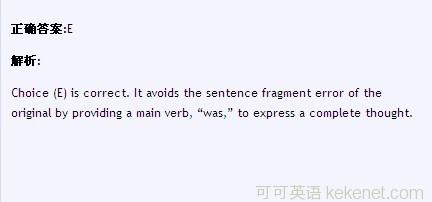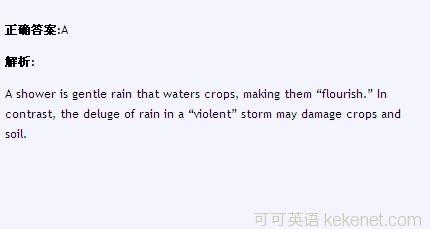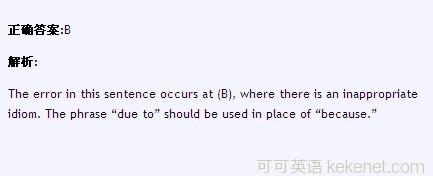参考答案:
Answer to Question 81
To establish the clearest comparison between circumstances in 1973 and those in 1984, a separate clause is
171
needed to describe each year. Choices A and C, in failing to use separate clauses, are too elliptical and
therefore unclear. Choice A also incorrectly uses and and a semicolon to separate an independent clause and a
phrase. Choice D incorrectly separates two independent clauses with a comma; moreover, the placement of in
1984 is awkward and confusing. In choice E, that refers illogically to income, thereby producing the
misstatement that income rather than mortgage payments rose to forty-four percent in 1984. Choice B is best;
two properly constructed clauses that clearly express the comparison are separated by a semicolon.
Answer to Question 82
The logical comparison here is between large steel plants and small mills. Choices A, B, and C illogically
contrast large steel plants with [the] processing [of] steel scrap. Further, in choices B and C remaining is
not parallel with put; consequently, it is not clear exactly what is remaining economically viable. The contrast
between large plants and small mills is logically phrased in choices D and E, but remained in E is not parallel
with put. Choice D, the best answer, uses parallel verb forms to complete the construction have been able to
put... and remain.
Answer to Question 83
Only choice C, the best answer, produces a sentence in which every pronoun it refers clearly and logically to the
noun condition. In choices A and B, the phrase indicate that there . is one does not grammatically fit with
when it is not because it has no referent. Choices B and D are imprecise in saying that a test will fail to detect
when a condition is present, since the issue is the presence and not the timing of the condition. Further, its
presence in D leaves the it in when it is not without a logical referent: it must refer to condition, not presence.
Choice E repeats this error; also, the presence ... when it is there is imprecise and redundant.
Answer to Question 84
In choice A, the plural pronoun their does not agree in number with the singular noun person. Choices C, D,
and E can be faulted for failing to complete the construction One legacy ... is with a noun that matches the noun
legacy; these choices use verb forms--the infinitive to realize or the present participle realizing--in place of a
noun such as realization. Further, when in C and D is less precise than as in characterizing a prolonged and
gradual process such as aging. B is the best answer.
Answer to Question 85
Choice B is best. In A and D, have grown does not agree with the singular noun market. In addition, all of the
choices except B use plural verbs after that, thus illogically stating either that bygone styles of furniture and
fixtures, or fixtures alone, are reviving the particular pieces mentioned; it is instead the market for those styles
that is bringing back such pieces, as B states. Furthermore, choices C and E, by using the verb form bring, fail
to convey the ongoing nature of the revival properly described by the progressive verb is bringing.
Answer to Question 86
In E, the best answer, the construction His right hand... crippled clearly and grammatically modifies the subject
of the sentence, Horace Pippin. In A, the use of the two participles Having and being is ungrammatical. Choice
B is awkward and changes the meaning of the original statement: the point is that Pippin's method of painting
arose because of, not in spite of, his injury. Choice C is wordy and awkwardly places the clause beginning that
crippled... so that it appears to modify the First World War rather than bullet. In choice D, The should be His,
and being should be omitted.
172
Answer to Question 87
Choice A is faulty because it uses the unidiomatic construction depends on if; whether is required to connect
depends on with the clause beginning it can.... Choice C uses whether or not where only whether is needed,
includes the awkward and wordy construction has the capability to, and unnecessarily repeats the idea of
capability with can. Choices D and E use unidiomatic constructions where the phrase its ability to broaden is
required. Choice B--idiomatic, concise, and correct--is best.
Answer to Question 88
The verbs are and calls indicate that the sculpture is being viewed and judged in the present. Thus, neither the
past tense verb constituted (in B) nor the present perfect verb have constituted (in C) is correct; both suggest
that the statue's features once constituted an artificial face but no longer do so. Also, B would be better if that
were inserted after so unrealistic, although the omission of that is not ungrammatical. Choices D and E use
unidiomatic constructions with enough: unrealistic enough to constitute would be idiomatic, but the use of
enough is imprecise and awkward in this context. Choice A, which uses the clear, concise, and idiomatic
construction so unrealistic as to constitute, is best.
Answer to Question 89
Choices A, B, and C appropriately use the construction "one X for every thirty-two Y's" to describe the ratio of
computers to pupils, but only C, the best answer, is error-free. In A, are does not agree with the subject, one
microcomputer; furthermore, in A, B, and D, than is used where as is required. Choices D and E reorder and
garble the "one X ..." construction, making four times as many refer illogically to pupils.
Answer to Question 90
The clause beginning Since 1986... indicates that the practice described in the second clause continued for
some period of time after it began. Choice D, the best answer, supplies the present perfect have begun, which
conveys this continuity; D also uses a construction that is appropriate when "allow" means "permit": allow... to
be based on. Choices A, B, and E incorrectly use the past tense began rather than the present perfect;
furthermore, in each of these options, they has no referent, since officers is a possessive modifier of fees.
Choices A and C include the awkward phrase based on how the funds they manage perform. Choices C and
E incorrectly use allow that.. .fees be based.
以上就是SAT语法练习题(九)含答案及解析的详细内容,考生可针对文中介绍的方法进行有针对性的备考。
















